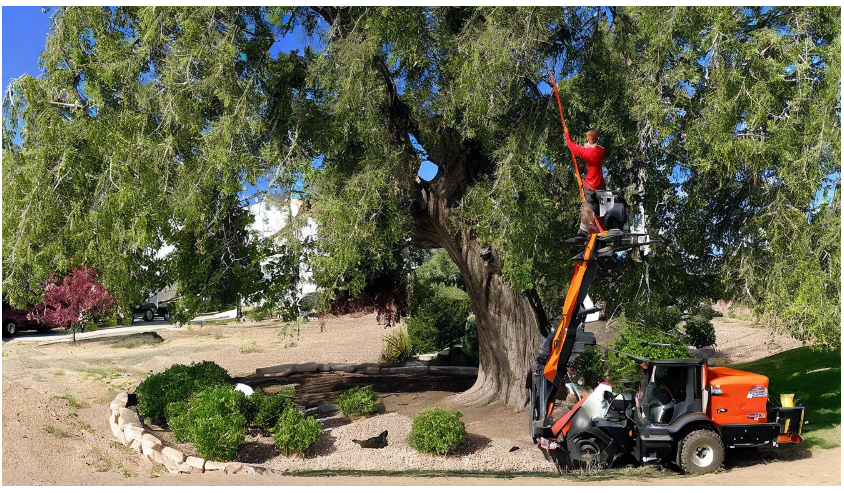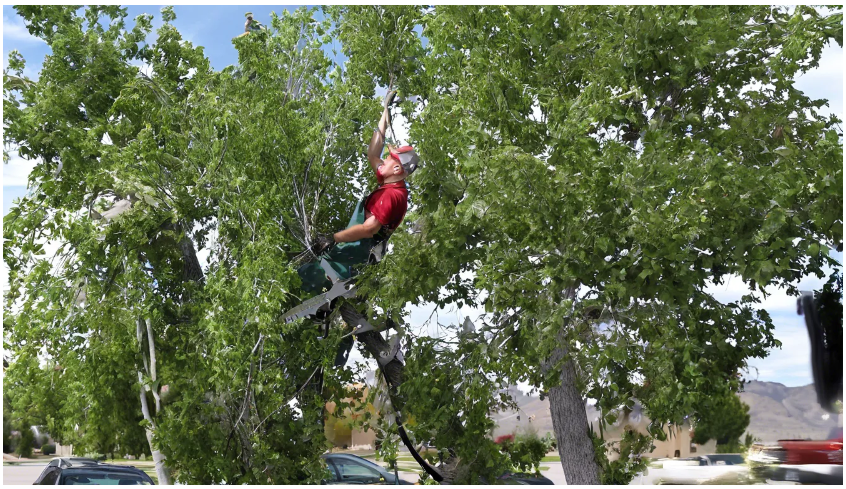The topic “the dangers of overpruning trees” explores the negative consequences and risks associated with excessive or improper pruning practices on trees. Pruning is a necessary maintenance technique that promotes tree health, safety, and aesthetics. However, when pruning is carried out excessively or incorrectly, it can lead to significant harm to trees, affecting their overall well-being and long-term survival. Overpruning refers to the removal of an excessive amount of branches, leaves, or foliage, often beyond what is necessary for the tree’s health and structural integrity.
Excessive pruning can lead to a range of detrimental effects on trees, impacting their physiological, structural, and ecological aspects. These dangers of overpruning include:

- Stress and Shock: Overpruning removes a significant portion of a tree’s foliage, limiting its ability to perform photosynthesis, the process through which trees produce energy. This puts the tree under stress and weakens its overall health. The shock from sudden and excessive pruning can lead to slowed growth, reduced vigor, and increased vulnerability to diseases and pests.
- Reduced Canopy and Photosynthesis: The removal of an excessive amount of leaves reduces the tree’s surface area for photosynthesis. As a result, the tree’s ability to produce energy from sunlight is compromised, affecting its growth and food reserves.
- Susceptibility to Sunburn: Overpruning can expose previously shaded bark to direct sunlight. Bark that was not previously adapted to sunlight can become sunburned and damaged, making the tree more susceptible to diseases and insect infestations.
- Compromised Structural Integrity: Removing too many branches can weaken the tree’s overall structure and stability. This can lead to limb failure, where branches are more likely to break or fall during storms or under their own weight, posing safety hazards to people and property.
- Elevated Risk of Infection: The cuts made during overpruning create wounds that serve as entry points for pathogens, including bacteria and fungi. These pathogens can infect the tree, causing diseases like cankers, rot, and decay that can further weaken the tree’s health.
- Loss of Aesthetic Value: Overpruning can lead to an unnatural and deformed appearance of the tree. Instead of enhancing aesthetics, excessive pruning may result in an unbalanced and unhealthy growth pattern.
- Resource Allocation Issues: Trees allocate their resources, such as nutrients and energy, to different aspects of their growth and survival. Overpruning redirects these resources to support regrowth, leaving fewer resources available for root growth, nutrient uptake, and defense mechanisms against pests and diseases.
- Risk of Rapid Re-Growth: Overpruned trees may respond with vigorous re-growth known as “water sprouts” or “suckers.” These rapid, weak shoots are more susceptible to breakage and may require additional pruning, exacerbating the tree’s stress.
- Long-Term Impact: While some immediate aesthetic goals may be achieved through overpruning, the long-term health and resilience of the tree are compromised. Over time, these negative effects can compound, leading to the gradual decline and even death of the tree.
It’s important to understand the dangers of overpruning and to approach tree pruning with care and consideration for the tree’s health and natural growth patterns. By adhering to proper pruning techniques and guidelines, individuals can ensure the well-being and longevity of trees in urban and natural environments.
Importance of Discussing Proper Pruning Practices for Tree Health
Discussing proper pruning practices for tree health is of paramount importance due to the significant impact that pruning can have on the well-being, longevity, and overall vitality of trees. Proper pruning techniques are essential to maintaining the structural integrity, aesthetics, and ecological contributions of trees in both urban and natural environments. Here’s why discussing proper pruning practices is crucial:

- Tree Health and Longevity: Proper pruning helps maintain the health of trees by promoting balanced growth, reducing stress, and preventing the spread of diseases and pests. Trees that are well-pruned are more likely to live longer, thrive, and provide their intended benefits for generations.
- Structural Integrity: Pruning can help shape a tree’s structure in a way that encourages strong and healthy growth. Removing weak, crossing, or crowded branches reduces the risk of limb failure and promotes a well-balanced canopy.
- Preventing Overpruning: As discussed earlier, overpruning can lead to numerous detrimental effects on trees. Understanding proper pruning practices helps prevent the dangers associated with excessive or improper pruning, preserving tree health and vigor.
- Disease and Pest Management: Pruning can help remove infected or infested branches, limiting the spread of diseases and pests. Proper cuts and sanitation practices reduce the risk of pathogens entering the tree through wounds.
- Enhanced Aesthetics: Proper pruning contributes to the aesthetic appeal of landscapes by maintaining the natural form of trees. Well-pruned trees look more attractive and visually pleasing, enhancing the overall beauty of outdoor spaces.
- Safety: Regularly pruning dead, diseased, or hazardous branches minimizes the risk of falling limbs, which can pose safety hazards to people, property, and infrastructure.
- Environmental Sustainability: Healthy trees contribute to ecosystem health by providing habitat for wildlife, improving air quality, sequestering carbon dioxide, and reducing the urban heat island effect. Proper pruning supports these ecological roles.
- Educational Opportunity: Discussing proper pruning practices educates individuals, including homeowners, landscapers, and arborists, about responsible tree care. This knowledge empowers them to make informed decisions and contribute to healthy urban forests.
- Avoiding Future Costs: Correctly pruned trees are less likely to require costly maintenance or corrective measures down the line. Avoiding improper cuts that can lead to structural issues or disease infestations saves both time and money.
- Preserving Ecosystem Services: Urban trees provide essential ecosystem services, such as stormwater management, shade, and air purification. Proper pruning supports these services, enhancing the overall environmental quality of urban areas.
- Professional Development: For arborists and tree care professionals, understanding proper pruning practices is essential for maintaining industry standards and providing high-quality tree care services.
- Community Engagement: Public discussions about proper pruning practices encourage community members to engage in responsible tree care practices, fostering a sense of stewardship and ownership over local green spaces.
In essence, discussing proper pruning practices is essential for fostering a holistic approach to tree care that considers the health, safety, aesthetics, and ecological contributions of trees. By promoting informed and responsible pruning practices, communities can ensure that their urban and natural landscapes remain resilient, vibrant, and sustainable over time.
Benefits of Proper Pruning for Tree Structure and Growth
Proper pruning plays a crucial role in enhancing tree structure and promoting healthy growth. By following correct pruning practices, trees can develop strong, well-balanced branches and maintain their natural form. The benefits of proper pruning for tree structure and growth include:

- Strong Branch Attachment: Proper pruning encourages the development of strong branch attachments, where branches are securely connected to the trunk. This reduces the risk of branch failure, preventing safety hazards caused by falling limbs.
- Reduced Risk of Co-Dominant Stems: Co-dominant stems occur when two or more main stems of similar size compete for dominance. These stems are prone to splitting or breaking during storms. Proper pruning helps identify and address co-dominant stems, reducing the risk of failure.
- Enhanced Canopy Structure: Correct pruning practices create a well-spaced and open canopy that allows sunlight to penetrate evenly. This results in balanced growth and prevents the formation of dense, weak growth patterns.
- Aesthetic Appeal: Proper pruning maintains the natural shape and appearance of trees, enhancing their visual appeal. Well-pruned trees contribute to the overall beauty of landscapes and urban environments.
- Air Circulation and Light Penetration: Pruning improves air circulation within the canopy, reducing the risk of fungal infections and diseases. It also allows sunlight to reach lower branches, promoting healthier growth throughout the tree.
- Reduced Weight on Branches: Removing dead, diseased, or weak branches reduces the overall weight carried by healthy branches. This relieves stress on the tree’s structure and reduces the risk of breakage.
- Improved Fruit Production: Proper pruning can enhance fruit production in fruit-bearing trees by allowing more sunlight to reach fruit-bearing branches. This results in better-quality and more abundant fruit.
- Minimized Risk of Disease Spread: Pruning removes infected or diseased branches, preventing the spread of pathogens within the tree. By creating clean cuts and practicing good sanitation, the risk of disease transmission is reduced.
- Regulated Growth: Pruning can control the growth rate of trees, preventing them from becoming too leggy or top-heavy. This is especially important for trees near structures or utility lines.
- Directing Growth: Properly pruned trees can be directed to grow in specific directions, avoiding obstacles, structures, or areas where their growth might become problematic.
- Encouraging New Growth: Strategic pruning stimulates the growth of new shoots and branches, promoting overall tree health and rejuvenation.
- Longevity: Trees that receive proper pruning care tend to live longer due to reduced stress, enhanced structural integrity, and minimized risks associated with improper growth.
- Proactive Maintenance: Regular pruning allows arborists to identify potential issues, such as disease, pest infestations, or structural weaknesses, and address them early on, preventing further damage.
- Professional Tree Care: Engaging certified arborists or trained professionals for proper pruning ensures that trees receive skilled care that aligns with their individual species, growth patterns, and needs.
In summary, proper pruning practices are essential for maintaining healthy tree structure, promoting balanced growth, and enhancing the aesthetic and functional qualities of trees. By adopting responsible pruning techniques, individuals and communities can ensure the long-term health, safety, and beauty of their trees while contributing to the overall well-being of urban and natural environments.
If you need a tree service in Utah, you can call:
Truco Services, Inc.
4640 Commerce Drive
Murray, Utah 84107
(801) 466–8044
https://truetreeservices.com/


